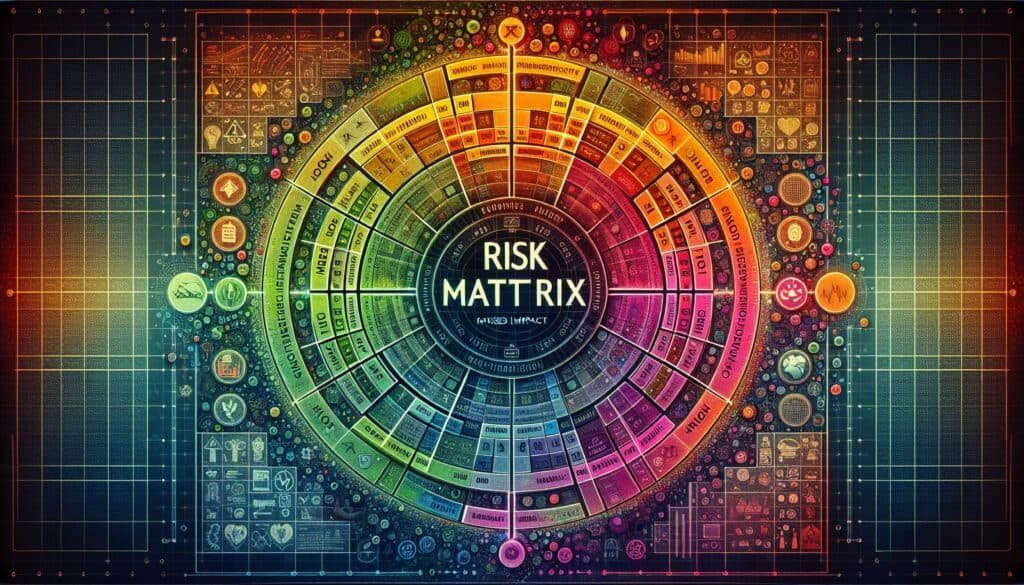Herramienta visual utilizada para evaluar y priorizar los riesgos en función de su probabilidad de ocurrencia y la gravedad de sus posibles consecuencias.
- Metodologías: Ergonomía
Matriz de riesgos

Matriz de riesgos
- Mejora continua, Mejora de procesos, Gestión de proyectos, Seguro de calidad, Control de calidad, Gestión de calidad, Análisis de riesgos, Gestión de riesgos
Objetivo:
Cómo se utiliza:
- Una cuadrícula en la que un eje representa la probabilidad de que se produzca un riesgo (por ejemplo, baja, media, alta) y el otro eje representa la gravedad de su impacto (por ejemplo, menor, moderado, mayor, catastrófico). Los riesgos se representan en la matriz, y las diferentes zonas (por ejemplo, verde, amarillo, rojo) indican los niveles de riesgo y la prioridad de la acción.
Ventajas
- Manera sencilla e intuitiva de visualizar y comparar riesgos; Facilita la comunicación sobre niveles y prioridades de riesgo; Ayuda a decidir qué riesgos requieren atención urgente y esfuerzos de mitigación.
Contras
- Puede ser subjetivo, ya que las evaluaciones de probabilidad y gravedad a menudo se basan en la opinión de expertos o en escalas cualitativas.
Categorías:
- Fabricación, Diseño de producto, Gestión de proyectos, Calidad, Gestión de riesgos
Ideal para:
- Evaluar y priorizar rápidamente múltiples riesgos para determinar cuáles merecen atención inmediata y asignación de recursos para su mitigación.
La metodología de la Matriz de Riesgos encuentra una amplia aplicación en diversos sectores, como la construcción, la sanidad, los servicios financieros y el desarrollo de productos, en los que la identificación y gestión de los peligros potenciales es imprescindible para el éxito del proyecto. Esta herramienta es especialmente útil durante la fase de evaluación de riesgos de los proyectos, ya que permite a los equipos visualizar los riesgos en función de su probabilidad e impacto, lo que sirve de base a las decisiones estratégicas relacionadas con la asignación de recursos y las estrategias de mitigación de riesgos. En este proceso suelen participar directores de proyecto, ingenieros, responsables de seguridad y partes interesadas, que evalúan y priorizan colectivamente los riesgos basándose en la matriz trazada. Por ejemplo, en el desarrollo de software, una matriz de riesgos puede ayudar a los equipos a reconocer las vulnerabilidades potenciales y su gravedad, guiándoles a la hora de abordar aquellas que amenazan la funcionalidad y la experiencia del usuario. La sencillez del mecanismo de la rejilla facilita la comunicación efectiva entre equipos multidisciplinares, garantizando que todos compartan un entendimiento común de los niveles de riesgo, lo que mejora la colaboración y la toma de decisiones informadas. En sectores muy regulados, esta metodología favorece el cumplimiento de la normativa al delimitar claramente las áreas que requieren atención inmediata, promoviendo así un enfoque proactivo y no reactivo de la gestión de riesgos.
Pasos clave de esta metodología
- Identificar los riesgos potenciales relevantes para el proyecto.
- Evaluar la probabilidad de que se produzca cada riesgo utilizando criterios definidos.
- Evaluar el impacto potencial de cada riesgo, clasificándolos en niveles de gravedad.
- Sitúe cada riesgo en la matriz en función de su probabilidad e impacto.
- Analice los riesgos trazados, identificando los que se encuentran en zonas de alta prioridad para la acción.
- Desarrollar y aplicar estrategias de mitigación de los riesgos prioritarios.
- Supervisar y revisar periódicamente los riesgos, actualizando la matriz en caso necesario.
Consejos profesionales
- Actualizar periódicamente la matriz de riesgos basándose en nuevos datos y en la evolución de las condiciones del proyecto para garantizar su exactitud y pertinencia.
- Incorporar los comentarios de las partes interesadas en las evaluaciones de riesgos para mejorar la comprensión de los posibles impactos y probabilidades.
- Utilice métodos cuantitativos, como el análisis del árbol de fallos o el análisis de los efectos de los modos de fallo (AMFE), junto con la matriz de riesgos para obtener una visión más profunda de los riesgos.
Leer y comparar varias metodologías, recomendamos el
> Amplio repositorio de metodologías <
junto con otras más de 400 metodologías.
Sus comentarios sobre esta metodología o información adicional son bienvenidos en la dirección sección de comentarios ↓ , así como cualquier idea o enlace relacionado con la ingeniería.
Contexto histórico
1960
1960
1969
1976-05-28
1980
1990
1960
1965
1970
1980
1980
(si se desconoce la fecha o no es relevante, por ejemplo "mecánica de fluidos", se ofrece una estimación redondeada de su notable aparición)











Publicaciones relacionadas
Calculadora de METS a calorías
Metaanálisis
Asignación de mensajes
Diagramas de modelos mentales
Fuerzas de empuje y tracción máximas admisibles
Planificación de necesidades de material (MRP)